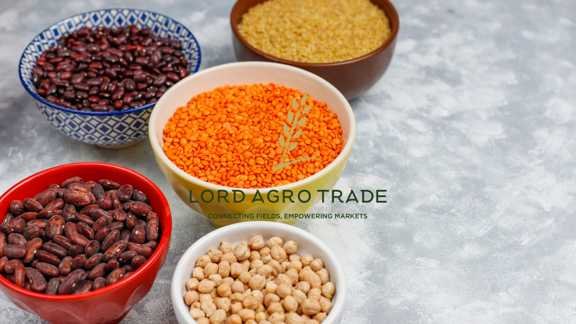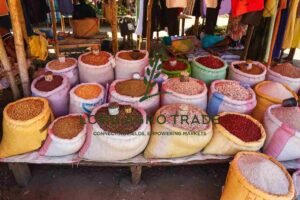Gulfood
17 To 21 FEB 2025 | DUBAI WORLD TRADE CENTRE
We’re excited to see you at Gulfood 2025!
Gulfood
17 To 21 FEB 2025 | DUBAI WORLD TRADE CENTRE
We’re excited to see you at Gulfood 2025!


Lentils, small yet impressive legumes, are an important part of human nutrition and have been for a long time. Canada, in the last few years, has become one of the world’s major producers and suppliers of lentils, significantly affecting its domestic and international food markets.
The prairies of this country, especially the Saskatchewan province, have been a place where large-scale lentil farming is taking place, which, besides contributing to Canada’s agricultural economy, is also a big part of global food security.
In this piece, we will talk about the location of lentil farming in Canada, the process of planting and the kinds of lentils produced, their economic value, and the difficulties in the future of this sector that keep on growing by the minute.

While lentil consumption has been documented over the last 9,000 years in parts of the Middle East and South Asia, large-scale production in Canada started more recently. In fact, the cultivation of lentils in Canada was virtually nonexistent before the 1970s, and their production has been rising steeply ever since.
Originally grown in small experimental plots, the adaptability of lentils to dryland farming regions of Canada became evident. Technological breakthroughs in the areas of agronomy, breeding, and world trade turned lentils into a crop of global importance in the prairie provinces of Canada.
The heart of lentil production in Canada lies in the Prairie Provinces, especially:
It is worth mentioning that Saskatchewan confirms the leadership of the county with the fact that over 90% of Canada’s lentils are grown in this province.
This really is the perfect place to grow the best lentils with its semi-arid climate, friendly growing seasons, and brown and dark brown chernozem (the greatest, certainly Brown and Dark Brown Chernozem) soils in the world, especially Brown and Dark Brown Chernozem soils.
Large are locations like Swift Current, Moose Jaw, and Regina which are completely surrounded by countless hectares of lentil fields.
The output of Alberta and Manitoba may not be as high as the production of Saskatchewan, but these two provinces are also in the list of regions where lentils are grown.
Less than 10% of the crops in these provinces are the size of the national total, but they are of great significance as far as research and crop rotation diversification is concerned.

It is now clear that Canada is a big producer of different lentil types which are very popular in the market.
The usual variety that farmers grow and sell extensively. Usually, this is the first step when exporting this product. Mainly, soups, stews, and dals are the application areas where this product is used and is particularly liked in the South Asian and Middle Eastern markets.
The range covers both large green lentils (e.g., Laird lentils) and medium/small types.
Usually, to prevent them from sprouting, producers keep the seed coats on them.
Beluga lentils (black), Puy-type green lentils (French), and other types are the ones that are also grown but on a small scale.
These are usually the types that out-of-the-ordinary big eaters go for.
Climate and Soil Requirements
Lentils are dependent on a moderate, arid environment with scarce moisture to grow properly.
The Canadian prairies provide an 85–120-day growing season time that is perfect for lentils.
Lentils by themselves supply nitrogen which makes the soil more fertile for the next crops.
Crop Rotation
It is common to alternate lentils with cereals (wheat, barley) and oilseeds (canola).
This practice of crop rotation not only minimizes the risk of diseases but also ensures the health of the soil and controls the weeds.
Seeding and Harvest
The best time for sowing lentils is in the early spring (April-May).
Most of the time the extraction of lentils is carried out in August-September.
And now direct harvesting has been a trend and usual with a view to modern combine harvesters and desiccants.

Lentils have been at the heart of the pulse industry in Canada for quite some time and this industry has been generating billions of dollars annually for the national economy.
Canada’s highest production record of lentils has gone beyond 2 million tonnes.
Lentils are most often one of the five top agricultural exports in terms of value.
Only in Saskatchewan, the lentil industry even surpasses an amazing sum of hundreds of millions of dollars to the national budget on an annual basis.
The cultivation of lentils is a source of livelihood for thousands of families residing in the Prairies.
Factories for processing, companies for transportation, exporters of goods and agronomists benefit as well from the lentil business track.
Despite making progress, the Canadian lentil industry faces several obstacles:
Trade Barriers
Import restrictions and tariffs levied by major markets, such as India, can be detrimental to exports.
Global trade can also be easily disrupted by political and diplomatic problems.
Climate Change
Meteorological extreme hazards such as drought, flooding, and cold weather are occurring more and more often.
Changes in precipitation patterns can lead to fluctuations in the load that the yield can carry.
Disease and Pests
Ascochyta blight, anthracnose, and other fungal diseases are among the dangers that may cause the destruction of crops.
Resistance management and crop rotation are significant in restricting the propagation, mainly of fungal diseases.
Market Volatility
Global price volatility and aggressive competition from other lentil producers like Australia and India result in Canadian farmers experiencing economic uncertainty.
Canada has poured wealth into the research to promote output and organic growth in the domain of lentil farming.
Notable Institutions:
University of Saskatchewan
Agriculture and Agri-Food Canada (AAFC)
Saskatchewan Pulse Growers (SPG)
Key Areas of Research:
Breeding improved disease-resistant lentil varieties
Building better drought tolerance
Looking at the carbon sequestration and the environmental benefits of lentils
Research on processing that adds value and plant-based protein products
Lentils in Canada seem to have a good future as the world is increasingly looking for healthy, sustainable, plant-based food products.
Trends that Will Lay the Course for the Future of Lentils in Canada:
Every year, more people opt for a vegan or vegetarian diet all over the world.
Attention is focused on climate-smart agriculture.
New plant-based meat products with lentil protein emerge in the market.
Products produced locally are becoming a more significant aspect of the value chain before exporting a product.
Currently, Canada is in a very positive position attributed to its investment in R&D, diversification in trade, and widespread adoption of sustainable solutions.

Canada’s lentil crops have shifted from a marginalized crop to a stronghold in agricultural production and export. With such robust infrastructure, knowledgeable farmers, and a global quality reputation, Canada is definitely a trendsetter in the lentil industry.
Setting aside the fact that Canadian lentils are the pride of the fields of Saskatchewan and an indispensable part of every house around the world, they also illustrate innovation and hard work and the power of commonly neglected legumes to inspire global change.